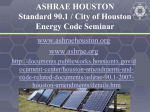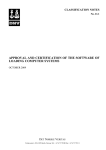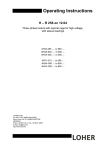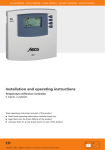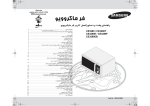Download 10 - Airside Design.indd - Oregon State Library: State Employee
Transcript
Oregon Non-Residential Building Energy Code Airside System Design Requirements These sections fall under 1318.2 Complex Control Systems. They are grouped here as the topic Airside Design because they affect the fundamental system design, including system type selection and system layout. Simultaneous Heating and Cooling The intent of section 1318.2.1 is to minimize energy waste by limiting the amount of simultaneous heating and cooling that occurs in HVAC systems. Simultaneous heating or cooling occurs when supply air that has been previously cooled is reheated, supply air that has been previously heated is recooled, or supply air that has been cooled is mixed with supply air that has been heated. The most important consequence of this requirement is that certain HVAC system types are prohibited except under special circumstances. The following system types are generally not allowed: Code Language Documentation: 1318.2.1 Simultaneous heating and cooling. Zone thermostatic and humidistatic controls shall be capable of operating in sequence the supply of heating and cooling energy to the zone. Such controls shall prevent reheating, recooling, and mixing or simultaneous supply of air that has been previously mechanically heated with air that has been previously mechanically cooled. The simultaneous heating and cooling requirements are documented on Form 4b, Line 4 as well as Worksheet 4k. Zone isolation controls are documented on Form 4b, Line 11. Compliance with separate air distribution requirements must be recorded on Form 4b, line 10. Exceptions: • Constant-volume reheat system. A single air handler that provides a constant flow of cool air to multiple zones, with a hot water or electric resistance coil at each zone to reheat the air and control space temperature. 1. Variable air volume (VAV) systems which, during periods of occupancy, are designed to reduce the air supply to each zone to a minimum before reheating, recooling or mixing takes place. This minimum volume shall be no greater than the larger of the following: 1.1 Thirty percent of the peak supply volume; 1.2 The minimum required to meet ventilation requirements, unless increasing the volume to critical zones (zones with the highest ratio of outside air to total supply air) beyond the minimum ventilation requirements results in a decrease in overall outside air required by the HVAC system. An increase beyond minimum ventilation rates shall not be applied to more than 20 percent of the zones with reheat, on any one system; or 1.3 0.4 cfm/ft2 (2 L/s per m 2) of zone conditioned floor area. 2. Zones where special pressurization relationships or cross–contamination requirements are such that variable air volume systems are impractical, such as some areas of hospitals and laboratories. Systems which use this exception and supply heated or cooled air to multiple zones shall include controls which automatically reset supply air temperatures by representative building loads or by outside air temperature unless it can be shown that supply air temperature reset increases overall building annual energy costs. • Two-deck multizone system. A single air handler that serves multiple zones and delivers a mixture of heated and cooled air to each zone in a separate duct. The ratio of heated and cooled air is varied separately for each zone to control space temperatures. • Constant-volume dual-duct system. Similar in principle to the multizone system, except that the mixing occurs at the zone level instead of within the air handler. Those system types are allowed in only three special cases: 1) where constant airflow is necessary to maintain pressure relationships between spaces in order to prevent cross-contamination, 2) where reheat is necessary to maintain special humidity conditions, and 3) where reheat is provided by recovered waste heat or solar heat. This code section generally requires the use of one of the following system types. • Variable air volume (VAV) with or without reheat • VAV dual-fan, dual-duct • Single zone systems, such as fan coils, packaged rooftop units, or water-source heat pumps. For VAV systems, section 1318.2.1 regulates the minimum airContinues on page 2 Code Language continues on page 2 1 Continued from page 1 Code Language continued from page 1 flow setpoint on VAV boxes. The code establishes an upper limit, and the intent is to reduce airflow as much as possible during low cooling-load periods before using reheat. 3. At least 75 percent of the energy for reheating or for providing warm air in mixing systems comes from a site–recovered or site–solar energy source. 4. Zones where specified humidity levels are required to satisfy process needs, such as computer rooms, museums and areas of hospitals. 5. Zones with a peak supply air quantity of 300 cfm (142 L/s) or less. There are three options for calculating this limit, and the designer can apply the method that results in the highest airflow. There is also an exception for zones with peak airflow no greater than 300 cfm. The first calculation option, 30 percent of peak air flow, and the third method, 0.4 cfm per square foot, are fairly simple. The second calculation method is more complicated than the other two because it is based on overall system outdoor air ventilation rate calculations. 1318.2.6 Zone isolation controls. A system serving multiple occupancies or floors in the same building shall be independently zoned and equipped with isolation devices capable of automatically shutting off the supply of conditioned air and outside air to and from each isolated area. Each isolated area shall be controlled independently and satisfy temperature setback (Section 1317.4.2) and optimum start control requirements. The central fan system air volume shall be reduced through fan speed reduction. The second method typically applies to zones with high occupant density, and it allows system designers to optimally solve Equation 6-1 in ASHRAE Standard 62.1-2004. That equation shows that the amount of outdoor air required for a system is a function of how much air is supplied to the “critical zone” in the system. The higher the supply air rate to the critical zone, the less outdoor air is required at the air-handler. The designer would determine which is more energy efficient, increasing outdoor air intake and minimizing reheat at the critical zone, or increasing the supply air rate and reheat energy required at the critical zone and minimizing the outdoor air rate. This “upsizing” of the minimum flow may only be applied to a maximum of 20 percent of the zones with reheat on each system. The designer should submit calculations demonstrating that increasing the volume to critical zones reduces overall outdoor air fraction. A detailed discussion of ventilation rate calculations is beyond the scope of this fact sheet, and more details are available in ASHRAE Standard 62.1-2004 and its User’s Manual. Exceptions: A cooling system less than 240,000 Btu/ hr (70 kW) or a heating system with less than 300,000 Btu/hr (88 kW) total capacity. 1318.2.7 Separate air distribution systems. Zones with special process temperature requirements and/or humidity requirements shall be served by separate air distribution systems from those serving zones requiring only comfort conditions; or shall include supplementary control provisions so that the primary systems may be specifically controlled for comfort purposes only. Exceptions: Zones requiring only comfort heating or comfort cooling that are served by a system primarily used for process temperature and humidity control provided that: When specifying VAV box settings, the designer should consider the energy savings opportunities for minimum airflow set points that are significantly lower than upper limits set by the energy code. Reducing the minimum flow set point saves fan energy as well as cooling and heating energy. Studies of real buildings have shown that many zones operate at their minimum flow for a majority of the time because cooling loads are often lower than predicted by the designer. A good resource for recommendations is the Advanced VAV System Design Guide. 1. The total supply air to those comfort zones is no more than 25 percent of the total system supply air, or 2. The total conditioned floor area of the zones is less than 1,000 square feet (90 m2) There are several potential design strategies that provide good comfort and ventilation performance in heating mode while allowing low minimum settings in VAV boxes. The potential problem with low air flow is that the velocity of the buoyant warm supply air will be too low to provide adequate mixing with room air. Thermal stratification (warm air at the ceiling, cool air at the floor) is more likely to occur as the supply air temperature gets warmer (more buoyant) and the velocity of air leaving the diffuser decreases. There are some strategies to combat stratification in heating mode. Parallel fan-powered VAV boxes have fans that turn on to increase air flow in heating mode and draw the extra air from the return air plenum. In addition to improving comfort in heating mode, parallel fan-powered boxes will reduce or eliminate the need for reheat. Series fan-powered VAV boxes are another, Continues on page 3 Airside System Design Requirements 2 Oregon Non-Residential Building Energy Code Continued from page 2 though less desirable option, which maintain constant discharge air flow while allowing the primary (ventilation) airflow to decrease to a minimum setpoint. A series fan-powered box provides good comfort performance but is generally less energy efficient because it induces warm plenum air at all but peak cooling times, leading to increased cooling requirements as well as higher fan energy. Another alternative is to use separate perimeter heating systems such as radiant panels or baseboard heaters instead of reheat coils in VAV boxes. In this strategy, the VAV box air flow can be allowed to drop to a low minimum without concern of stratification occuring, and the separate heating system prevents overcooling. Examples Q A 1,000 square foot space is served by a VAV box sized for 1,500 cfm peak airflow. What is the upper limit on the minimum air flow setting for the VAV box? A Section 1318.2.1 sets the limit at the largest of 30 percent of peak airflow, 0.4 cfm per square foot, or the amount required for ventilation. In this case, the 30 percent option yields 450 cfm (30 percent of 1,500 cfm) and the 0.4 cfm per square foot option yields 400 cfm. Using the larger of these two results allows the minimum VAV box flow to be set as high as 450 cfm. However, it is possible that the outdoor air ventilation rate required for this space would exceed 450 cfm for high density cases such as a meeting room or classroom. If that is the case, then the ventilation rate can be used as the upper limit. Finally, there is an exception in Section 1318.2.1 that allows the minimum flow to be set even higher if doing so will reduce the overall outdoor air ventilation rate for the central air handler. Zone Isolation Controls The intent of Section 1318.2.6 is to avoid conditioning the whole building at times when only portions are occupied. These zone isolation control requirements apply to systems that serve more than one occupancy or multiple floors. At a minimum, such systems must be able to serve each occupancy or each floor independently while shutting off air flow to and from the other areas served by the system. In addition, each isolation area must have independent time-of-day, setback, and optimal-start controls. These requirements do not apply to small HVAC systems. Cooling systems smaller than 20 tons (240,000 Btu/hr) of cooling capacity are exempt. Heating systems with capacity of less than 300,000 Btu/hr are also exempt. Q Is a triple-deck multizone system, which has hot deck, cold deck, and neutral (no heating or cooling) deck, allowed under the simultaneous heating and cooling requirements of Section 1318.2.1? A straight-forward option for complying with these requirements is to include motorized dampers that shut off supply and return ducts to each isolation zone. In a multi-story building, this option might consist of dampers located at the connections to the supply and return air shafts to isolate each floor. The local fire official may allow the use of fire/smoke dampers to serve this purpose as long as they are wired so that life-safety controls take precedence over off-hour controls. A Yes, as long as the controls do not allow the mixing of air from the cold and hot decks. In other words, the controls must ensure that the air delivered to each zone is a mix of cold and neutral or hot and neutral. A VAV system might comply if it has the capability to set the operating schedule of each zone (or at least sets of zones) independently, so that the VAV box damper may be shut on some zones while others continue to operate. A direct digital control (DDC) system should be able to provide this level of control. However, the code also requires that return air flow from the isolation zone be shut off, and additional motorized dampers in the return air path will still be necessary. Q The VAV system in a multi-story office building is being provided with motorized dampers on the supply and return ducts at each floor to provide zone isolation control. The toilet rooms are exhausted by central fan. Is it also necessary to provide isolation dampers for the toilet exhaust at each floor? The code also requires that central systems with zone isolation controls use fan speed control to throttle back flow when one or more zones is shut off. Most large central systems will already meet this requirement because variable speed fan control is now common for duct pressure control in new VAV systems. A Yes, Section 1318.2.6 requires that the air flow to and from each isolation zone, in this case each floor, is capable of being shut off. Therefore, motorized dampers in the exhaust duct will be required at the connection to each floor. Separate Air Distribution Systems Many buildings include spaces that require special environmental conditions. Examples of such spaces include hospital operating rooms, laboratories, special material storage such as rare books, Continues on page 4 Oregon Non-Residential Building Energy Code 3 Airside System Design Requirements Continued from page 3 Examples clean rooms or other special manufacturing spaces, computer rooms, or other special electronic equipment. Q A two-story building is served by a water-loop heat pump system, consisting of 25 heat pumps that total 100 tons of cooling capacity. A central air handler delivers ventilation air to each heat pump. This air handler has a heating coil to temper outdoor air during the winter. How do the zone isolation controls apply? The energy required to maintain conditions in these “process” spaces is typically greater than for spaces where human comfort is the only criterion. The intent of section 1318.2.7 is that these spaces with process requirements be served by separate systems so that energy is not wasted by “overconditioning” the other portions of the building. A If the heating capacity of the central air handler is 300,000 Btu/hr or more, then isolation capability is required for delivery of outside air to each floor, and exhaust or return air paths from each floor would require isolation dampers. In some cases, it may not be practical to provide separate systems, and the code allows some exceptions. These exceptions permit a small amount of “comfort” conditioned space to be served by systems that primarily serve the process areas. The comfort areas must either receive no more than 25 percent of the air flow or must be less than 1,000 sq. ft. Q A data center consists of computer rooms with special temperature and humidity requirements as well as supporting office and storage spaces. Can the support areas be served by the same air handler that serves the computer rooms? For More Information See also the fact sheets covering Airside Control Requirements, Air Transport Energy, Economizers, Ventilation Controls for High Occupancy Areas, and Exhaust Air Heat Recovery. See the Advanced VAV System Design Guide for detailed recommendations on VAV box minimum airflow settings. Available at http://www.newbuildings.org/mechanical.htm. A Section 1318.2.7 of the code allows the support areas to share the computer room air handler under two conditions: 1) the total floor area of the support rooms is less than 1,000 sq. ft. or 2) the air flow provided to the support areas is less than 25 percent of the total system air flow. See also ASHRAE Standard 62.1-2004 Ventilation for Acceptable Indoor Air Quality and the Standard 62.1-2004 User’s Manual for guidance in determining ventilation rates and in performing “critical zone” calculations. Available at www.ashrae.org. Find Out More Copies of code: Oregon Building Officials Association phone: 503-873-1157 fax: 503-373-9389 Technical Support: Oregon Department of Energy 625 Marion Street NE phone: 503-378-4040 Salem, OR 97301-3737 toll free: 800-221-8035 www.oregon.gov/energy fax: 503-373-7806 Examples This fact sheet was developed with funding from the Northwest Energy Efficiency Alliance and the US Department of Energy under contract DE-FG-R. Q An office building includes a 200 square foot retail space adjacent to the lobby as well as a 2,000 square foot cafeteria. May these spaces be served by the central HVAC system? A Yes, these zones can be served by the central system. The separate air distribution system requirements (1318.2.7) do not apply in this case because the primary system serving the office spaces is being controlled only for comfort purposes. However, the zone isolation requirements of Section 1318.2.6 require that the system be able to shut off air flow to and from these different occupancies separately from the office occupancies. In addition, if this is a multi-story building, then each floor must have isolation controls capability. Photo on page c/o Warren Gretz, DOE/NREL / ODOE CF-/Fact Sheet Non-residential code HVAC fact sheets include: • Ventilation Controls System • Economizers • Exhaust Air Heat Recovery • Airside Design Requirements • Hydronic Design, Controls • Airside Controls • Large Volume Fan Systems • Air Transport Energy • Simple vs. Complex HVAC Systems Airside System Design Requirements 4 Oregon Non-Residential Building Energy Code





